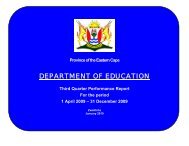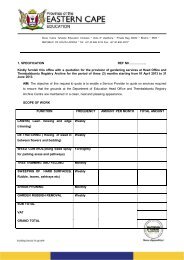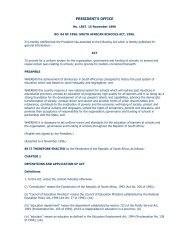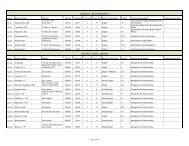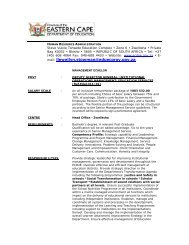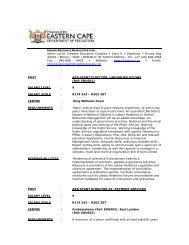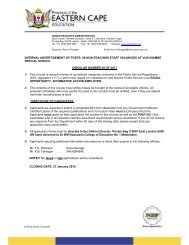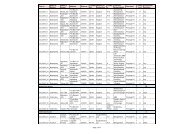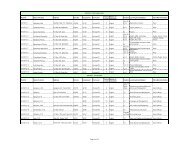School Community Integration Pilot Project - Department of Education
School Community Integration Pilot Project - Department of Education
School Community Integration Pilot Project - Department of Education
Create successful ePaper yourself
Turn your PDF publications into a flip-book with our unique Google optimized e-Paper software.
A comparative analysis <strong>of</strong> education expenditure in Eastern Cape schools – November 2004<br />
7. CONCLUSIONS AND RECOMMENDATIONS<br />
7.1. Conclusions<br />
This study has established a number <strong>of</strong> findings from analysis <strong>of</strong> provincial and<br />
Eastern Cape public school indicators and expenditure:<br />
National and provincial funding for education<br />
• Following a difficult period <strong>of</strong> very limited available resources from 1997/98 to<br />
2000/01, the Eastern Cape has been able to significantly increase<br />
expenditure on public schooling in recent years, primarily due to high real<br />
growth above the rate <strong>of</strong> inflation in national to provincial transfers and in<br />
allocations to education within the province.<br />
• This trend is however unlikely to continue as the growth rate <strong>of</strong> transfers from<br />
national will decrease and population and enrolment trends are likely to give<br />
the Eastern Cape a declining share <strong>of</strong> national transfers to provinces.<br />
• Since 2001/02 rapidly increasing expenditure on social grants has decreased<br />
the share <strong>of</strong> expenditure on education and health in all provinces. The<br />
Eastern Cape has however reduced the share <strong>of</strong> expenditure on education<br />
more rapidly than in any other province, from 40,6% in 2001/02 to 34,7% in<br />
2003/04.<br />
• Capital expenditure on addressing school infrastructure backlogs and nonpersonnel<br />
non-capital spending on learning resources and school services are<br />
equally vital areas <strong>of</strong> spending to educator provisioning. It is important to<br />
maintain a balance between these three broad categories <strong>of</strong> expenditure.<br />
Prioritising resources in education<br />
• In comparison to other provinces the Eastern Cape has a favourable<br />
learner:educator ratio and a high learner:classroom ratio indicating high<br />
school infrastructure backlogs. The Eastern Cape is a province <strong>of</strong> small<br />
schools with the second lowest average enrolment per school in the country.<br />
• A favourable LER and a high LCR indicates a relative misallocation <strong>of</strong><br />
resources between educator and classroom provisioning given limited<br />
funding.<br />
• The Eastern Cape has made a strategic choice to prioritise a low<br />
learner:educator ratio leading to relatively favourable educator post<br />
provisioning relative to other education resources. Other provinces have<br />
clearly set different relative priorities, enabling higher levels <strong>of</strong> resourcing for<br />
non-personnel non-capital and capital expenditure.<br />
• The Eastern Cape has attached a lower priority to addressing the classroom<br />
backlog or to providing learner materials in the classroom and school<br />
services, in comparison to relatively favourable levels <strong>of</strong> educator<br />
provisioning. Most <strong>of</strong> the districts in the former Transkei have a more<br />
favourable learner:educator ratio than the Western Cape. In the context <strong>of</strong><br />
48



